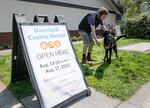
Oregon’s state climatologist, Larry O’Neill, says one alarming trait of recent heat waves in the state is that the nights are not cooling down as much.
Courtesy of Oregon State University
This week’s oppressive and deadly heat wave is finally beginning to wind down in some parts of Oregon. But this is no time to get comfortable. Although some relief from the extreme heat is coming soon, climate scientists are predicting that heat waves could happen more frequently and be more intense in the Pacific Northwest.
OPB’s “All Things Considered” host Tiffany Camhi talked with Oregon’s state climatologist, Larry O’Neill, to learn more about why we’re experiencing more of this extreme weather.
Tiffany Camhi: State researchers predicted a warmer and a drier August this year due to a naturally occurring weather pattern known as El Niño. Is the heat wave we’re experiencing now due to that warmer El Niño weather pattern?
Larry O’Neill: Yes, in part, it is due to the warmer El Niño pattern. What we’re seeing is that the whole Pacific Ocean from the equator, where the El Niño is generally measured, up through the coast of the Pacific Northwest is much warmer than normal. So that is definitely contributing to the intensity of the heat wave. We do have heat waves that naturally occur throughout the country and in the Pacific Northwest. But this one is much more intense than historical heat waves. It’s among the longest lasting and warmest that we’ve experienced in our recorded history. And we’ve experienced a few others like it over the last few years. The June 2021 heat dome is a good example of that.
Camhi: So you mentioned that heat waves occur naturally in the Pacific Northwest. How has climate change affected that?
O’Neill: It’s essentially made them hotter. So instead of having a 95-degree day, which back in the 20th century would have been considered a very hot day in the Pacific Northwest, our temperatures have risen somewhere between 2 to 4 degrees Fahrenheit from our average temperatures decades ago. So a 95-degree day would be nearly 100 degrees now.

Matthew Kennedy holds his dog, Juno, outside of the Beaverton Overnight Shelter on Aug. 15, 2023. "I was using up to 10 gallons of water a day to wet down my animals and keep them cooled off," Kennedy says. "You have to have A/C. There's no other way."
Caden Perry / OPB
Camhi: So a 2- to 4-degree difference doesn’t sound like that much. Can you talk a little bit more about the human impacts of it being that much warmer?
O’Neill: The human impacts are that it just doesn’t cool down as much at night. Generally, when we’ve had heat waves, people would just open up their windows at night and be able to get relief from the really hot temperatures during the day. And also it was just a day or two of really warm temperatures. Most people could deal with those fairly well. But with that 2 to 4 degrees, what we’re finding is that there are more heat illnesses, more admittance to hospital emergency rooms and more 911 calls that have to do with heat illness or heat stress.
Another thing that we’re also finding is that heat waves tend to co-occur with other extreme events, such as droughts and wildfires. A good example of that right now is around Eugene. The last couple of days, we’ve had a lot of smoke from wildfires in addition to the 105 degree temperatures. And so for people who don’t have air conditioning, it’s simply a very poor option to just throw open the windows when the air quality index outside is around 300. That’s a very unhealthy or hazardous category to expose yourself to. So these co-occurrences of extreme weather events are also quite problematic.
Camhi: And I know that you track a lot of historical climate data in Oregon. What kind of story is that data telling?
O’Neill: It depends how you define a heat wave. So a traditional definition would be days above 90 degrees Fahrenheit. We are seeing more of those days and we’re seeing more consecutive days like that. Portland and Eugene used to get something like 12 to 17 days during the summer above 90 degrees Fahrenheit. Now we’re seeing somewhere between 25 and 40 days per summer. And this summer we’ll be close to setting a record by that measure.
The other really concerning thing is that the night time temperatures are also warming, possibly faster than the daytime temperatures. So usually in the Pacific Northwest we get the sea breeze, especially in Western Oregon and Washington, by 4 o’clock in the afternoon. No matter how hot it was, we’d reliably get a sea breeze that can knock things down 10 or 20 degrees. Now we’re finding that the nighttime temperatures are also increasing quite a lot. And so we’re just not able to cool down as much at night as we used to.

An air conditioning unit at the Gresham, Ore., cooling center on Aug. 15, 2023. Staff at this cooling center ran these units, several fans and turned out the lights to maximize cooling output for people inside.
Caden Perry / OPB
Camhi: So considering that climate scientists are predicting hotter and longer heat waves here. What should people start doing right now to adapt?
O’Neill: The number one thing people can do is to get air conditioning. And if you live in some place where you’re renting, try to get it provided for you. Air conditioning is the number one adaptation that we can take to prevent against heat illness and heat stress.
Camhi: What about specific behavior changes we should be thinking about?
O’Neill: This isn’t just a transient phenomenon. This isn’t something that is part of a natural cycle that will go away. This is something that will be permanent. What the climate models are projecting is that as long as we keep the high emissions of greenhouse gasses, we’re going to continue warming. These problems will either persist or get worse in the next 20 or 30 years. And so we should really think about the fact that we haven’t reached a new plateau, a new normal. This is going to keep happening until we mitigate our greenhouse gas emissions.
Camhi: So since we’re just going to get warmer, what advice do you have for people who might be feeling some sort of anxiety over the effects of climate change?
O’Neill: Adaptation is obviously going to be an important component of our response. However, I have some optimism because there are paths forward that reduce our emissions. This is in the form of increased adoption of electric vehicles, improvements to our electrical power grid and the introduction of renewable energy supplies that are zero carbon. I’m also very hopeful because younger people today have been grappling with this since an early age and they’re taking this much more seriously than people did 30 or 40 years ago.
So we have a lot of power right now. The climate model projections show a variety of pathways we can take. If we reduce emissions and reduce greenhouse gas concentrations, we can make a big difference for what the climate will be like by the end of the century. I think there’s a lot of hope there.
